Even with your social media presence and the content on your site, email still plays an irreplaceable role for your business. In fact, real estate has a higher email open rate than many other industries—nearly 33 percent, according to Constant Contact.
Property Manager's Guide to Attracting and Retaining Small Portfolio Investors
Hear from hundreds of small-portfolio investors on what it takes to win their business
Get the GuideWhen it comes to property management in today’s environment, digital communications demand even more attention, clarity, and nuance to keep your business running smoothly and safely.
In this article, we’ll discuss several situations in which email can boost your marketing strategy and help you engage with residents and owners. We include sample text (aka property management email templates) for cold, follow-up, and thank-you emails. There’s also copy that will help you build and sustain relationships with your residents and owners, as well.
Overarching Email Best Practices
We’ll go over some of the basic types of emails you should be sending regularly. But for now, let’s cover some tips to help you get the most out of your email strategy.
The Anatomy of an Email
Before we even get into the mechanics, it’s critical to understand why you are writing the email and for whom: What’s in it for the recipient and what action do you want them to take? How will you incorporate the unique touch that only your property management company can deliver?
First, let’s talk about the key structural pieces of every email to give a lay of the land. You’ll notice there we list character counts next to each element—reason being, you have to take into consideration the space constraints that you face with mobile devices.
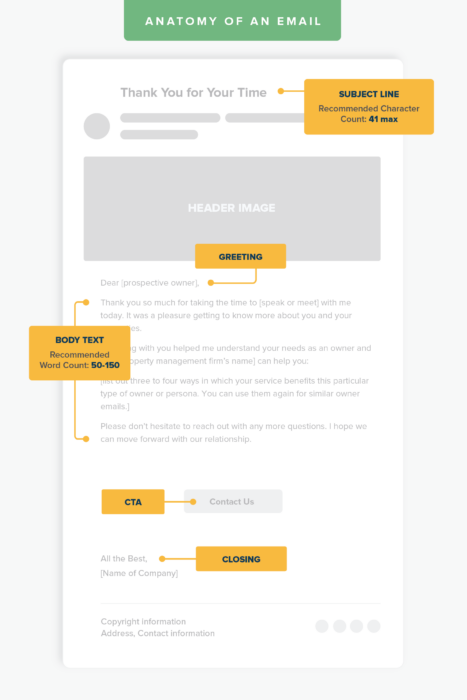
Subject Line
Recommended Character Count: 41 max
A subject line will make or break the success of your email. It’s the difference between an opened email and an ignored one. Hubspot lists a number of helpful tips for creating great subject lines.
In a nutshell, your subject lines should be short and to-the-point. They should be personalized and tell the recipient what to expect in the email. They should pique your recipient’s curiosity, compelling them to open it.
Preheader
Recommended Character Count: 40-130
This is a great opportunity to add detail to your subject line and is an often-overlooked tool. Make sure to not simply duplicate your subject line—use your preheaders to stoke curiosity and make someone even more interested in opening your email.
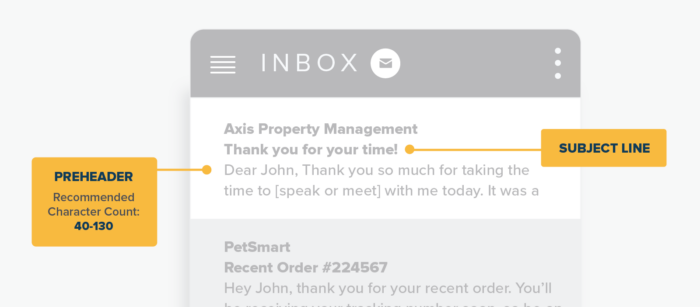
Greeting
Inc.com listed different greetings for all kinds of emails. Basically, you shouldn’t use the same greeting for every email. Instead, customize it to your purpose and your audience.
Body
Recommended Word Count: 50-150
The body of your email should be brief, to-the-point, and fulfill the promise of your subject line. Even though you could write a lot, it’s best to resist the urge in general. In fact, Hubspot says your promotional emails should stay within 50 and 150 words. There are of course many exceptions to this rule as it does not apply to longer-form communications like newsletters (more on newsletters below) or a landmark message from the business owner. The most important guiding design principle to remember is that any communication you put together should be easily scannable.
Some other important tips to help achieve visual clarity are to use short sentences, bullet points, and breaking up the body text into digestible paragraphs. These days it’s even common to see one sentence paragraphs.
CTA (Call to Action)
Recommended Character Count: 10-30
Your CTA is the spot where you entice your reader to take action, which usually means to click on a button or hyperlink of some sort. You want to inspire them to actually click (and that’s no small feat), so it makes sense to include one CTA that’s short, punchy, and related to your subject line’s intention. No more than three words is an ideal target. You can also hyperlink in the body anchor text to the same CTA as well.
Closing
Grammarly also has some great suggestions for sign-offs, as well. Like your greeting, your closing shouldn’t be generic. And don’t forget to include the appropriate contact information.
Build Your Email Lists
For property managers, there are generally two main email audiences: those for existing owners and residents and those for prospective owners and residents. Of course, you’ve already got an email list for the owners and residents you need to communicate with regularly. You’ve also got a list to attract and nurture new revenue for your business.
For prospective property owners:
- Include a contact request form on your website.
- If you write a blog, place calls to action at the bottom of posts that invite readers to sign up for more information or subscribe to a newsletter.
- Sign up for services such as All Property Management, which matches property managers with prospective owners.
For prospective residents
- Always have a guest book or visible contact information at open houses in the case of self showings.
- Include an information request form on your website.
- If you write a resident-facing blog, include calls to action in these posts, as well.
- Post and syndicate your rental listings online, and always have a clear way to get to the next step like a pre-screening questionnaire.
Frequency and Timing of Emails
The frequency of your emails depends on who your audience is and what you’re trying to accomplish. There are several types of email journeys (the series of emails someone receives after they take a certain action), and that plays into the frequency of emails, as well.
For instance, someone who filled out an information request form on your website might get an immediate phone call followed by a follow-up thank-you email, then, perhaps another follow-up every week or so. Someone who signed up for your newsletter would get the newsletter once a month, plus the occasional event announcement. On the other hand, someone who moved into one of your units may get a thank-you email, followed by a check-in at one month and six months—plus an anniversary email. It’s all about thinking through the key milestones that are best for each audience and your ideal communication patterns.
To determine the best day and time to send your emails, you’ll have to do a little trial and error. There are plenty of blog posts claiming to know the ideal day and time to get great open rates. Some say 11am is the best time. Some say Fridays are the best day. It actually can vary by industry, and by product, as no two audiences behave exactly alike.
To find out the best time for your audience, do some research, test out some days and time, and then track your open and click-through rates—you are the best judge of your own results and data.
Importance of Branding
Your brand is the impression you leave with your audience; how they perceive you and your services. It defines a group of traits, such as honesty, quality work, and care for people, much like people have. It’s communicated through your actions as a business. But it’s also conveyed through your website, your social media, and (yes) your email communications.
Your brand should be consistent across everything you create for your business, in the same way big brands create a consistent look and feel throughout all of their properties and channels. Make sure your emails carry the same colors, logo, language, and voice as the rest of your customer-facing materials.
All of this is much easier by working with an email marketing provider, or by using purpose-built property management email templates provided within another product suite. Software such as Goodjuju and Upkeep Media even have templates alongside with comprehensive marketing services, designed specifically for property managers. These specialized templates will not only give a more professional look compared to a plain-text email through Google or Outlook, but will also increase your email’s deliverability and decrease the likelihood that it will be identified as SPAM.
Personalization
Before you start writing emails, remember that personalized emails get more attention than generic ones. In fact, emails with personalized subject lines have 50% higher open rates.
Personalizing a message means more than adding a name to the greeting. You need to tailor your emails to fit your audience, their relationship to your business, and the kind of information that’s useful to them. The property management email templates below will help you do that.
Tools to Make Emailing Easier
Once you have your list and your email strategy, take advantage of tools that will help you bring all of it to life. Services such as MailChimp or Constant Contact can help you build and schedule branded, effective email journeys for prospective owners and residents at every stage of your marketing strategy.
For property managers, many property management platforms have built-in tools for creating and sending email messages easily to current owners and residents. Buildium even offers marketing tools built right into its property management platform.
Property Management Email Templates
There are different types of emails for the many needs of your marketing strategy, as well as for current residents and owners. Here are some of the more common types, when to use them, and a template to help you get started. You can also download all these property management email templates for free, here.
The Cold Email
A cold email is one you’re writing to someone with whom you’ve never been in touch before. Be it a prospective owner or a resident, they don’t know your brand so definitely don’t waste time with lengthy introductions. “My name is Jane Smith and I am the owner of Smith Property Management” will lose your audience’s attention instantly.
Prospective Owners
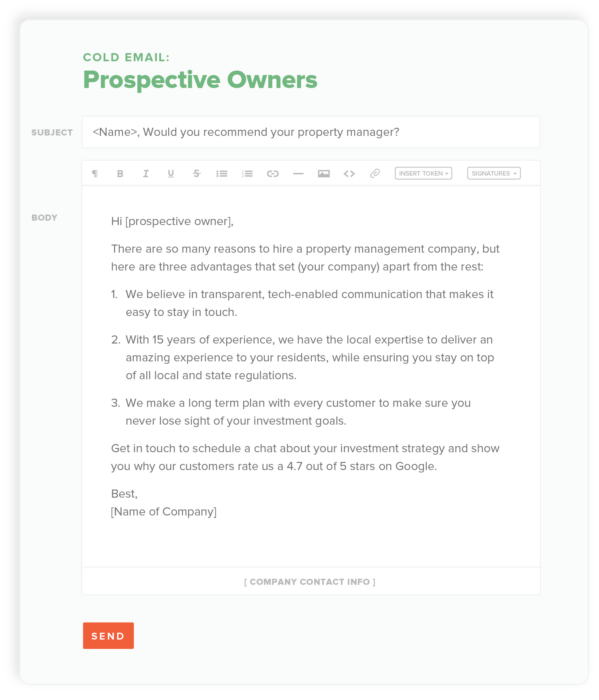
Lead Follow-Up Emails
Lead follow-up emails should be brief and to-the-point, as well. These are the emails you send after you meet someone, when a prospective owner or resident fills out a form on your site, or when someone gets in touch with you via your social channels. They should respond as quickly as possible anytime someone contacts them.
You would write a follow-up email to anyone who attended an open house or expressed interest in an online listing, as well. Notice that each email includes a friendly greeting, a thank you for reaching out, and contact information.
Pro Tip: A tool like Tenant Turner can automate follow-up emails and help you manage resident leads.
For prospective owners, the email will look something like this:
Post-Event
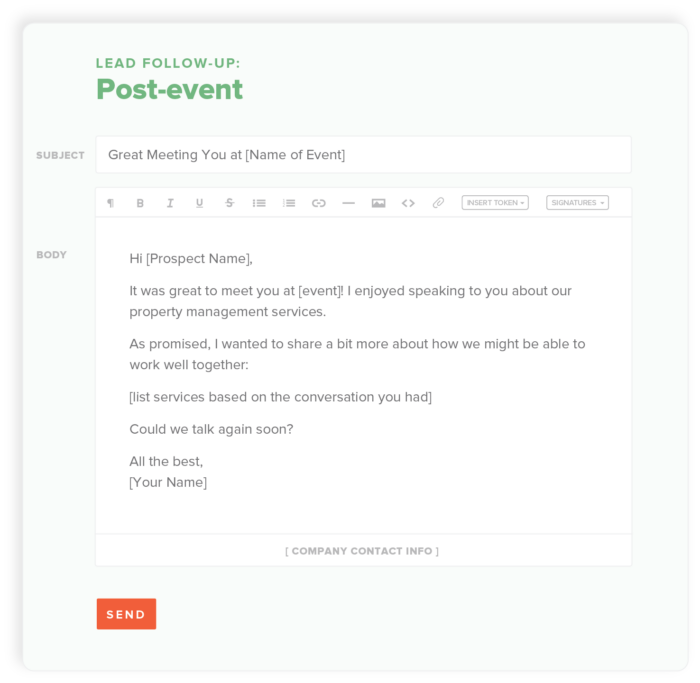
For prospective residents, try this approach:
Prospective Resident
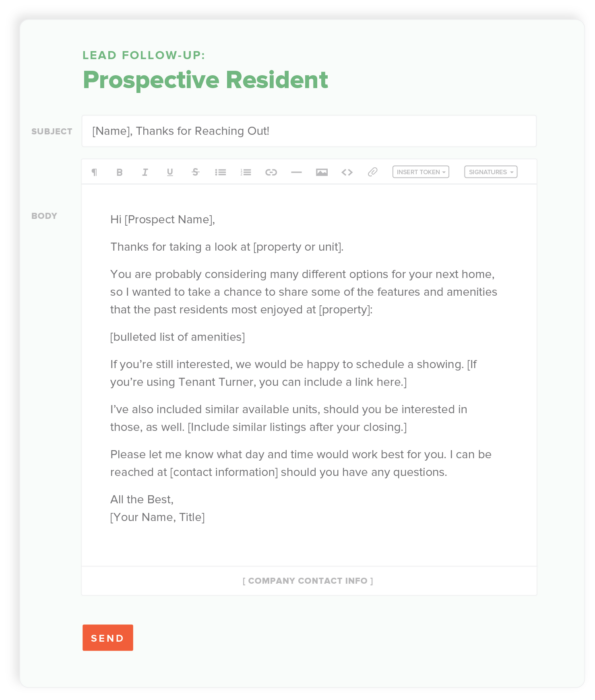
Post Showing / Open House
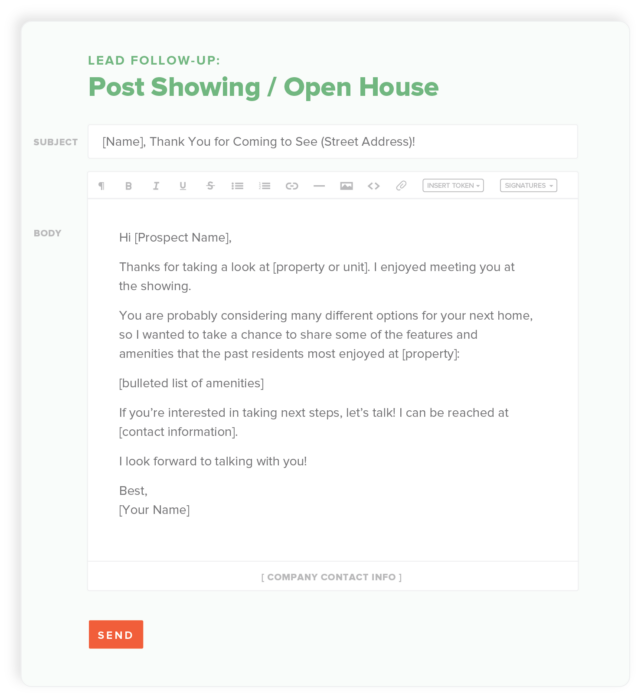
Thank-You Emails
This is another type of email you should send as soon as possible. You can email a quick thank you to owners after you speak or meet with them in person, as well as to prospective residents after they view a property.
These emails should start with a sincere thank you. You can use it to reiterate some of the features of your services, but you don’t want it to sound overly sales-y.
Thank-you emails are useful for residents or current owners who send you referrals, as well. These should be completely personal and sincere with a clear call to action on how to complete a referral.
Here’s an example:
After Meeting a Prospective Owner
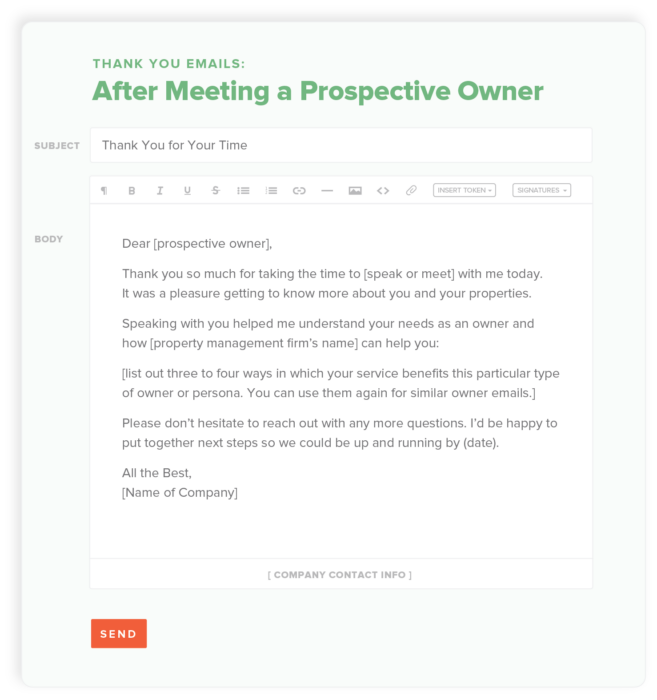
Welcome Emails
When a new resident moves in, or a new owner signs with you, a welcome email should pop up in their inbox almost immediately to celebrate the occasion.
A welcome email makes your new resident or own feel special, and it allows you to convey important information they need to know right up front. For new residents, that might include basic information like how to set up utilities, trash collection days, common area schedules, or how to log into your resident portal.
Custom property management email templates could include a move-in email, where you simply have to fill in the blanks.
For owners, a welcome email may include owner draw schedules, login information to your owner portal, or emergency contact information.
Check-In Emails
A check-in email is an extension of your welcome email. It’s another opportunity to reach out and engage with residents and owners. It’s a quick email, again, between 50 and 150 words, to ask if they have any questions or issues, and make sure everything is going as they expected. You could even include a quick survey to gather any feedback or suggestions.
For owners:
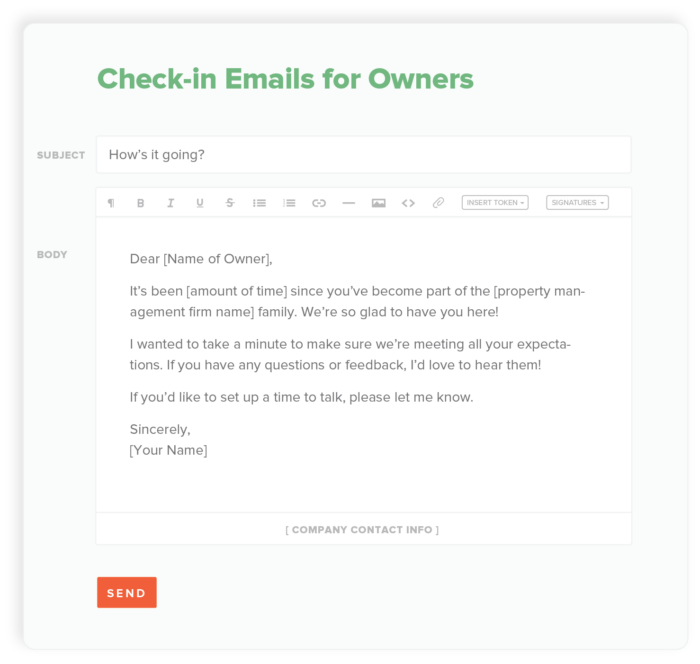
For residents:
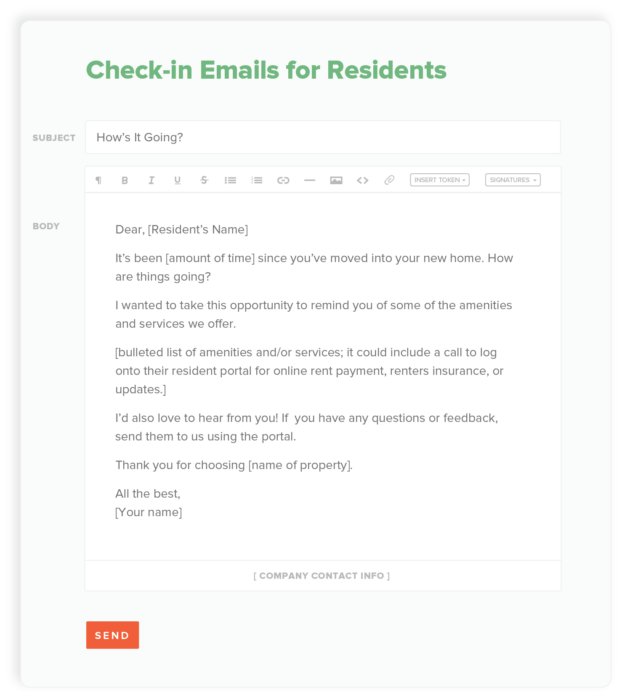
Anniversary and Event Emails
Everyone likes to recognize milestones. And showing that you remembered a resident’s move-in anniversary or the day an owner signed with you shows how much you care about the people and their experience. Engagement like that makes them more likely to remain loyal customers and recommend you to others.
Celebrating big events and accomplishments of owners can have the same result.
Emails celebrating events, such as awards, milestones, and birthdays, should be brief and personal. They shouldn’t include any sales language. They should simply be a sincere expression to mark the day.
Here are some examples:
Celebrating Owner Anniversaries
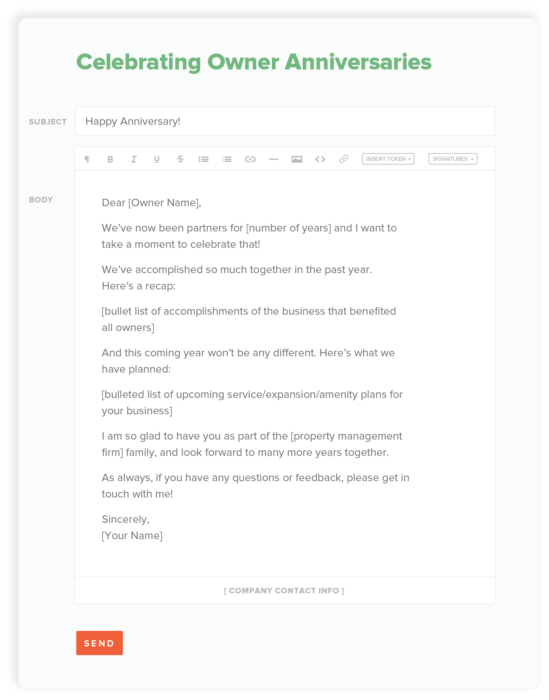
Celebrating Resident Anniversaries/Lease Renewals:
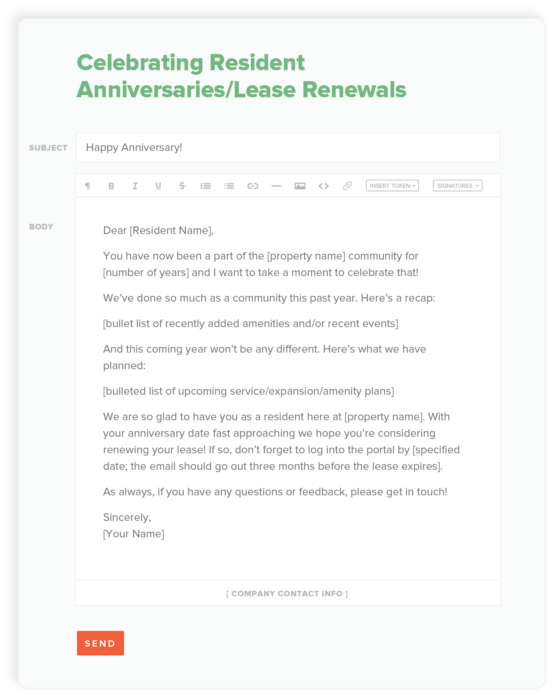
Referral Request
The final type of email on our list is the referral request. This is an especially helpful tool for attracting residents. It should be a short, personal email that asks honestly for a referral to other owners or prospective residents.
Pro Tip: Send this type of email to residents who have given you positive feedback or reviews. Couple it with an incentive, such as a gift card.
Here is an example:
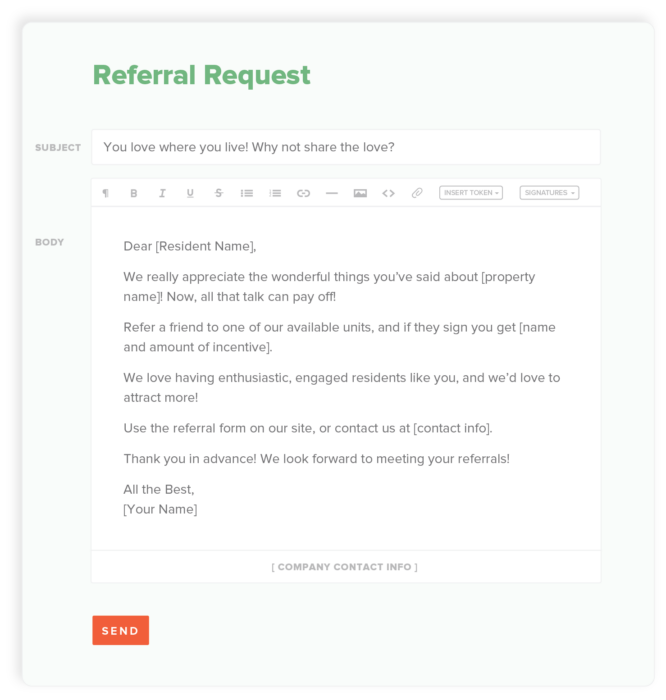
Email Newsletter
An email newsletter is a great way to stay top-of-mind with prospective residents and owners with a longer-form communication. You can include events and updates from your properties, business information, and listings for new and vacant units on your properties.
The important thing to remember is to make it clear what your readers will get upon signing up for a newsletter. You shouldn’t expect people to just want to click “join my email list.” Again, you have to consider what benefit is in it for them. A better option might be: “Get weekly updates on what’s happening in <local area> real estate” etc.
You also should set up a schedule for your newsletter. You don’t want to send one out every time something new happens. Instead, set up a regular frequency that works for your company. It will take some research and tweaking to get the right frequency for your email list, but most small businesses would consider monthly sends.
A newsletter for prospective clients and residents will have different information than one for current owners and residents.
A newsletter for prospective owners may include:
- A quick summary of industry news to showcase your industry knowledge
- Links to owner-facing blog posts that highlight your expertise
- Awards, accolades, or positive reviews you have received recently
- New services or features of your business
A newsletter to current clients may include:
- Upcoming events at properties you manage
- Unit listings
- New services of features at the properties you manage
- Awards, accolades, or positive reviews your properties have received recently
And newsletters may work even better for PMs of multifamily units, who have events at the complex, common space schedules, and regular maintenance updates to communicate.
These examples were written to attract and engage prospective current owners and residents, adding a personal touch and a friendly voice to reflect the sincere, approachable property management business you are. You can download all these property management email templates for easy access here.
These days, clear online communication benefits property managers in many other ways outside of the norm—as information changes rapidly and residents look for answers and guidance. Whether you’re communicating something straightforward or sharing out information to address their well-being and safety, a well-crafted email is central to connecting you to your residents and owners.
The bottom line is, emails are still an integral part of your marketing and communication strategies. And with a thoughtful and branded approach to your email communication, you’ll spend more time focusing on what’s essential.
Read more on Growth


